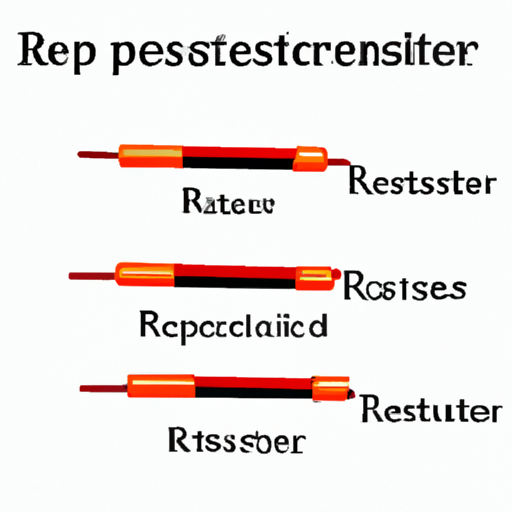What Kind of Product is Resistor 5?

I. Introduction
In the world of electronics, resistors play a crucial role in the functionality and efficiency of circuits. A resistor is a passive electrical component that limits or regulates the flow of electrical current in a circuit. They are essential for controlling voltage and current levels, ensuring that electronic devices operate safely and effectively. Among the myriad of resistors available in the market, Resistor 5 stands out as a specific product with unique characteristics and applications. This blog post will delve into the nature of Resistor 5, exploring its specifications, applications, and how it compares to other resistors.
II. Understanding Resistors
A. Basic Principles of Resistance
At the heart of understanding resistors is Ohm's Law, which states that the current (I) flowing through a conductor between two points is directly proportional to the voltage (V) across the two points and inversely proportional to the resistance (R). This relationship is expressed mathematically as:
\[ V = I \times R \]
Resistors come in various types, including fixed, variable, and specialty resistors, each serving different purposes in electronic circuits.
B. Function of Resistors in Circuits
Resistors serve several critical functions in electronic circuits:
1. **Current Limiting**: By restricting the flow of current, resistors protect sensitive components from damage due to excessive current.
2. **Voltage Division**: Resistors can be used in series to create a voltage divider, allowing designers to obtain a desired voltage level from a higher voltage source.
3. **Signal Conditioning**: In signal processing applications, resistors help shape and filter signals, ensuring that they meet specific requirements for further processing.
III. Overview of Resistor 5
A. Product Specifications
Resistor 5 is characterized by several key specifications that define its performance and suitability for various applications:
1. **Resistance Value**: Resistor 5 typically has a resistance value of 5 ohms, making it ideal for applications requiring low resistance.
2. **Power Rating**: The power rating indicates how much power the resistor can dissipate without overheating. Resistor 5 usually has a power rating of 1 watt, suitable for many low-power applications.
3. **Tolerance**: Tolerance refers to the precision of the resistor's value. Resistor 5 often comes with a tolerance of ±5%, ensuring that its resistance value remains within acceptable limits.
4. **Temperature Coefficient**: This specification indicates how much the resistance value changes with temperature. Resistor 5 generally has a temperature coefficient of ±100 ppm/°C, making it stable across a range of temperatures.
B. Physical Characteristics
The physical attributes of Resistor 5 also contribute to its functionality:
1. **Size and Form Factor**: Resistor 5 is typically available in a compact size, making it easy to integrate into various circuit designs.
2. **Material Composition**: Common materials used in Resistor 5 include carbon film or metal film, which provide stability and reliability.
3. **Packaging Options**: Resistor 5 is available in different packaging options, including through-hole and surface-mount configurations, catering to diverse manufacturing processes.
IV. Applications of Resistor 5
A. Common Uses in Electronic Devices
Resistor 5 finds applications across a wide range of electronic devices:
1. **Consumer Electronics**: In devices like televisions, smartphones, and audio equipment, Resistor 5 is used for current limiting and voltage division.
2. **Industrial Applications**: In industrial control systems, Resistor 5 helps manage power levels and protect sensitive components.
3. **Automotive Electronics**: Resistor 5 is utilized in automotive circuits for signal conditioning and power management, ensuring the reliability of electronic systems in vehicles.
B. Role in Circuit Design
In circuit design, Resistor 5 plays a vital role in:
1. **Signal Processing**: It helps filter and shape signals, ensuring that they meet the required specifications for further processing.
2. **Power Management**: Resistor 5 is used to manage power distribution within circuits, preventing overloads and ensuring efficient operation.
3. **Protection Circuits**: It serves as a protective element, safeguarding sensitive components from voltage spikes and excessive current.
V. Comparison with Other Resistors
A. Comparison with Standard Resistors
When compared to standard resistors, Resistor 5 offers specific advantages due to its unique specifications. Its low resistance value makes it particularly suitable for applications where minimal resistance is required.
B. Advantages of Resistor 5 Over Alternatives
1. **Precision**: With a tolerance of ±5%, Resistor 5 provides a reliable and consistent performance, making it a preferred choice for many applications.
2. **Compact Size**: Its small form factor allows for easy integration into tight spaces within electronic devices.
3. **Versatility**: Resistor 5 can be used in various applications, from consumer electronics to industrial systems, making it a versatile component.
C. Limitations and Considerations
While Resistor 5 has many advantages, it also has limitations. Its power rating of 1 watt may not be suitable for high-power applications, and designers must consider the environmental conditions, such as temperature and humidity, when selecting this resistor.
VI. How to Choose the Right Resistor
A. Factors to Consider
When selecting a resistor, several factors should be taken into account:
1. **Application Requirements**: Understanding the specific needs of the application, such as resistance value and power rating, is crucial.
2. **Environmental Conditions**: Consideration of temperature, humidity, and other environmental factors can impact the performance of the resistor.
3. **Cost Considerations**: Budget constraints may influence the choice of resistor, but it is essential to balance cost with performance and reliability.
B. Guidelines for Selecting Resistor 5
When choosing Resistor 5, ensure that its specifications align with the requirements of your circuit. Verify that the resistance value, power rating, and tolerance meet the needs of your application, and consider the physical characteristics for compatibility with your design.
VII. Conclusion
In summary, Resistor 5 is a vital component in the realm of electronics, offering a unique combination of specifications and applications. Its role in current limiting, voltage division, and signal conditioning makes it indispensable in various devices, from consumer electronics to industrial systems. As technology continues to evolve, the importance of understanding resistors, including products like Resistor 5, will only grow. Future trends in resistor technology may lead to even more efficient and reliable components, further enhancing the performance of electronic circuits.
VIII. References
A. Suggested readings on resistors and electronic components.
B. Relevant industry standards and guidelines for resistor selection and usage.
C. Online resources for further learning about resistors and their applications in electronics.
By understanding the significance of Resistor 5 and its applications, engineers and hobbyists alike can make informed decisions in their electronic designs, ensuring optimal performance and reliability.
What Kind of Product is Resistor 5?

I. Introduction
In the world of electronics, resistors play a crucial role in the functionality and efficiency of circuits. A resistor is a passive electrical component that limits or regulates the flow of electrical current in a circuit. They are essential for controlling voltage and current levels, ensuring that electronic devices operate safely and effectively. Among the myriad of resistors available in the market, Resistor 5 stands out as a specific product with unique characteristics and applications. This blog post will delve into the nature of Resistor 5, exploring its specifications, applications, and how it compares to other resistors.
II. Understanding Resistors
A. Basic Principles of Resistance
At the heart of understanding resistors is Ohm's Law, which states that the current (I) flowing through a conductor between two points is directly proportional to the voltage (V) across the two points and inversely proportional to the resistance (R). This relationship is expressed mathematically as:
\[ V = I \times R \]
Resistors come in various types, including fixed, variable, and specialty resistors, each serving different purposes in electronic circuits.
B. Function of Resistors in Circuits
Resistors serve several critical functions in electronic circuits:
1. **Current Limiting**: By restricting the flow of current, resistors protect sensitive components from damage due to excessive current.
2. **Voltage Division**: Resistors can be used in series to create a voltage divider, allowing designers to obtain a desired voltage level from a higher voltage source.
3. **Signal Conditioning**: In signal processing applications, resistors help shape and filter signals, ensuring that they meet specific requirements for further processing.
III. Overview of Resistor 5
A. Product Specifications
Resistor 5 is characterized by several key specifications that define its performance and suitability for various applications:
1. **Resistance Value**: Resistor 5 typically has a resistance value of 5 ohms, making it ideal for applications requiring low resistance.
2. **Power Rating**: The power rating indicates how much power the resistor can dissipate without overheating. Resistor 5 usually has a power rating of 1 watt, suitable for many low-power applications.
3. **Tolerance**: Tolerance refers to the precision of the resistor's value. Resistor 5 often comes with a tolerance of ±5%, ensuring that its resistance value remains within acceptable limits.
4. **Temperature Coefficient**: This specification indicates how much the resistance value changes with temperature. Resistor 5 generally has a temperature coefficient of ±100 ppm/°C, making it stable across a range of temperatures.
B. Physical Characteristics
The physical attributes of Resistor 5 also contribute to its functionality:
1. **Size and Form Factor**: Resistor 5 is typically available in a compact size, making it easy to integrate into various circuit designs.
2. **Material Composition**: Common materials used in Resistor 5 include carbon film or metal film, which provide stability and reliability.
3. **Packaging Options**: Resistor 5 is available in different packaging options, including through-hole and surface-mount configurations, catering to diverse manufacturing processes.
IV. Applications of Resistor 5
A. Common Uses in Electronic Devices
Resistor 5 finds applications across a wide range of electronic devices:
1. **Consumer Electronics**: In devices like televisions, smartphones, and audio equipment, Resistor 5 is used for current limiting and voltage division.
2. **Industrial Applications**: In industrial control systems, Resistor 5 helps manage power levels and protect sensitive components.
3. **Automotive Electronics**: Resistor 5 is utilized in automotive circuits for signal conditioning and power management, ensuring the reliability of electronic systems in vehicles.
B. Role in Circuit Design
In circuit design, Resistor 5 plays a vital role in:
1. **Signal Processing**: It helps filter and shape signals, ensuring that they meet the required specifications for further processing.
2. **Power Management**: Resistor 5 is used to manage power distribution within circuits, preventing overloads and ensuring efficient operation.
3. **Protection Circuits**: It serves as a protective element, safeguarding sensitive components from voltage spikes and excessive current.
V. Comparison with Other Resistors
A. Comparison with Standard Resistors
When compared to standard resistors, Resistor 5 offers specific advantages due to its unique specifications. Its low resistance value makes it particularly suitable for applications where minimal resistance is required.
B. Advantages of Resistor 5 Over Alternatives
1. **Precision**: With a tolerance of ±5%, Resistor 5 provides a reliable and consistent performance, making it a preferred choice for many applications.
2. **Compact Size**: Its small form factor allows for easy integration into tight spaces within electronic devices.
3. **Versatility**: Resistor 5 can be used in various applications, from consumer electronics to industrial systems, making it a versatile component.
C. Limitations and Considerations
While Resistor 5 has many advantages, it also has limitations. Its power rating of 1 watt may not be suitable for high-power applications, and designers must consider the environmental conditions, such as temperature and humidity, when selecting this resistor.
VI. How to Choose the Right Resistor
A. Factors to Consider
When selecting a resistor, several factors should be taken into account:
1. **Application Requirements**: Understanding the specific needs of the application, such as resistance value and power rating, is crucial.
2. **Environmental Conditions**: Consideration of temperature, humidity, and other environmental factors can impact the performance of the resistor.
3. **Cost Considerations**: Budget constraints may influence the choice of resistor, but it is essential to balance cost with performance and reliability.
B. Guidelines for Selecting Resistor 5
When choosing Resistor 5, ensure that its specifications align with the requirements of your circuit. Verify that the resistance value, power rating, and tolerance meet the needs of your application, and consider the physical characteristics for compatibility with your design.
VII. Conclusion
In summary, Resistor 5 is a vital component in the realm of electronics, offering a unique combination of specifications and applications. Its role in current limiting, voltage division, and signal conditioning makes it indispensable in various devices, from consumer electronics to industrial systems. As technology continues to evolve, the importance of understanding resistors, including products like Resistor 5, will only grow. Future trends in resistor technology may lead to even more efficient and reliable components, further enhancing the performance of electronic circuits.
VIII. References
A. Suggested readings on resistors and electronic components.
B. Relevant industry standards and guidelines for resistor selection and usage.
C. Online resources for further learning about resistors and their applications in electronics.
By understanding the significance of Resistor 5 and its applications, engineers and hobbyists alike can make informed decisions in their electronic designs, ensuring optimal performance and reliability.













